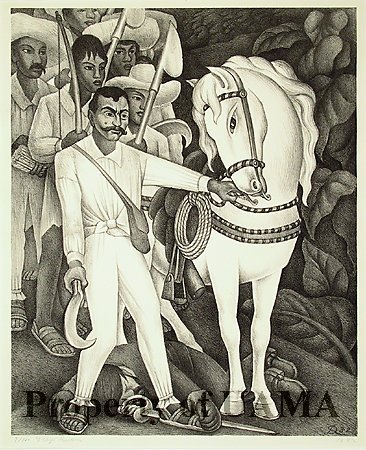Facts About Zapata
Diego Rivera's lithograph "Zapata" vividly captures the essence of the Mexican revolutionary Emiliano Zapata, depicted standing with a group of campesinos (peasants). Rivera created this piece twelve years after Zapata's assassination, drawing inspiration from his earlier fresco work. The lithograph was included in a series produced for Rivera's solo exhibition at the Museum of Modern Art in 1931, where it garnered considerable acclaim. Rivera’s transition to lithographic prints for the American art market was facilitated by his gallerist and friend.
"Zapata" is one of Rivera's most renowned prints. It shows Zapata holding the reins of a horse in one hand and a sickle in the other, surrounded by peasants armed with farming tools. The lithograph is characterized by smooth, curvilinear forms and gradations of tone, hallmarks of Rivera's style. Unlike earlier portrayals of Zapata as a charro revolutionary, Rivera presents him here as a campesino, emphasizing his status as a folk hero.
The lithograph's political and social themes resonate with the principles of Social Realism, underscoring the empowerment of the working class. Rivera’s thoughtful depiction of Zapata in various contexts highlights his careful consideration of the revolutionary leader's image. The print was part of a limited edition of 100, with many copies now housed in art museums around the world.
Rivera's "Zapata" lithograph holds a significant place in the history of Mexican and modern art, showcasing the artist's ability to convey political and social messages through his distinctive style.

 Mexico
Mexico